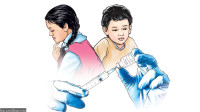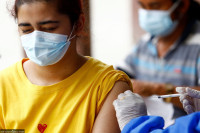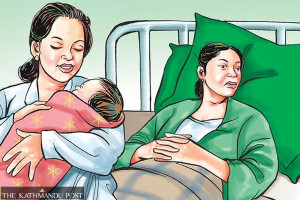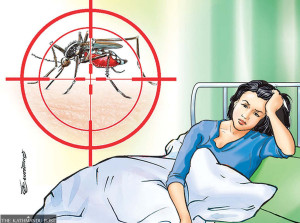Health
Nepal fears over 60,000 people could get infected with dengue in next three months
Experts call for urgent preparations including, strengthening health facilities and launching effective awareness campaigns.
Arjun Poudel
The number of dengue-infected patients visiting hospitals in the Kathmandu Valley has been gradually rising recently, and this could be just the beginning.
Experts warn that a sharp spike in cases is likely once the ongoing rainfall stops for a few days.
In the worst-case scenario, over 60,000 people could get infected with the dengue virus in the next three months, according to a projection prepared by the Epidemiology and Disease Control Division.
The division, which is responsible for the epidemic and outbreak control in the country, said that the figure is just an estimate, which is made for the preparation for possible worst-case scenarios.
“Every year, we made a projection of the worst-case scenario, which is required for internal preparedness,” said Dr Chandra Bhal Jha, director at the division. “Our projection does not mean the estimated number of people will be infected with the deadly virus. The infection number depends on the measures we take to lessen the risks.”
Dengue is a viral disease transmitted by female Aedes aegypti and Aedes albopictus mosquitoes. According to the World Health Organisation, the same vector also transmits chikungunya, yellow fever, and the Zika virus.
Since January, 1,673 people from 73 districts have tested positive for the dengue virus. The deadly virus has not yet been reported in four out of 21 mountain districts—Rasuwa of Bagmati province, Manang of Gandaki province, and Humla and Dolpa of Karnali province.
In 2024, 15 people died, and 41,865 others were infected as the virus spread to 76 districts. In 2023, 88 persons died and more than 54,000 were infected by the virus, which had spread to all 77 districts. At the time, hospitals in Kathmandu Valley were overwhelmed with dengue patients, and pharmacies had run out of paracetamol, the most widely used medicine to treat fever.
Experts say reported cases may represent only a small fraction of the true scale of infection, as around 90 percent of the infected people are asymptomatic, and many deaths and infections often go unreported.
Many people infected with dengue show mild symptoms, which do not need any treatment or can be managed with paracetamol at home.
Since dengue became endemic in Nepal years ago, meaning people get infected throughout the year, health officials no longer classify it as an outbreak of a deadly virus.
Officials at the division said that they have alerted all concerned health agencies about the looming crisis, supplied testing kits, and allocated a budget to carry out a dengue search-and-destroy drive.
“We have already sent Rs 80 million to local levels to carry out the dengue search and destroy drive,”said Jha. “Health workers and health facilities are asked for necessary preparation as the disease could break out at any time. We have also requested help from other sectors and the general public to destroy dengue breeding grounds. ”
Officials say an outbreak could occur in any place at any time, as most districts across the country have reported dengue cases.
Experts say that instead of counting the number of infected people, concerned authorities must focus on implementing mitigating measures.
Experts warn that the rising temperatures, coupled with monsoon rainfall, create the perfect environment for dengue-spreading vectors to breed. They say that unless the general public is made aware of the problem and takes it seriously, the spread of the dengue virus will not lessen. They asked the authorities concerned to learn from past experiences while taking preventive measures.
“Focus should be made on behavioural change, which needs continuous efforts and investments,” said Dr Sher Bahadur Pun, chief of the Clinical Research Unit at Sukraraj Tropical and Infectious Disease Hospital. “Breeding grounds of dengue-spreading mosquitoes could be anywhere, including schools, hospitals, private houses and others, and without the participation of the general public in dengue control efforts, we cannot expect control of infection of the deadly disease.”
Doctors say along with launching a search-and-destroy drive on a regular basis, authorities should also focus on strengthening the capacity of health facilities to prevent them from being overwhelmed in the event of a possible massive outbreak, experts say.
Dengue-transmitting mosquitoes breed in clean water and bite people in daylight. Uncovered water tanks and discarded objects such as plastic cups and bottles could be breeding grounds for dengue-carrying mosquitoes.
According to doctors, mild to high fever, severe muscle pain, rashes, severe headache and pain in the eyes are some symptoms of dengue. Doctors advise those with these symptoms to seek immediate treatment. While there is no specific cure for the disease, early detection and access to proper medical care can lower fatalities.
Nepal reported its first dengue case in a foreigner in 2004 in Chitwan district. Since then, an increasing number of dengue infections, including major outbreaks, have been reported from many districts.
The World Health Organisation says there is no specific cure for severe dengue, but early detection and access to proper medical care can save lives.




 7.12°C Kathmandu
7.12°C Kathmandu














